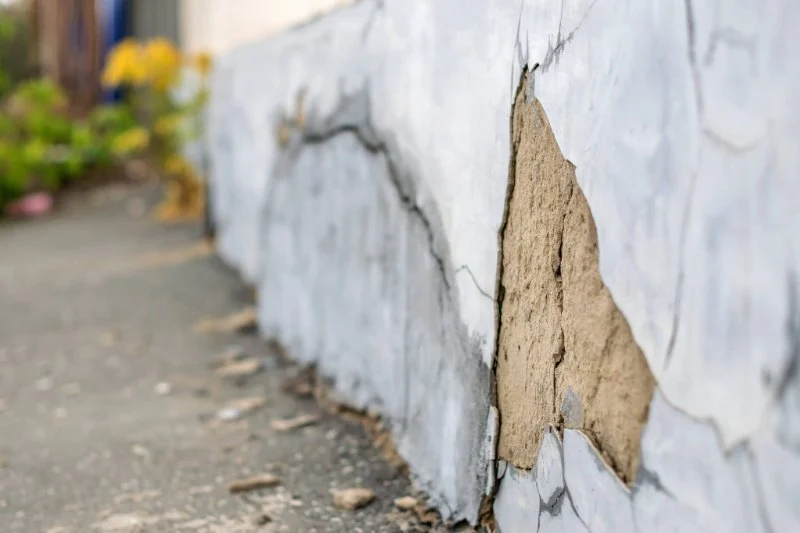
- Understanding-the-Importance-of-Sealing-Foundation-Cracks
- Common-Pests-Entering-Through-Foundation-Cracks
- Steps-to-Seal-Entry-Points-in-Foundation-Cracks
- Choosing-the-Right-Sealant-for-Foundation-Cracks
- Tools-and-Materials-Needed-to-Seal-Foundation-Cracks
- Common-Mistakes-to-Avoid-When-Sealing-Foundation-Cracks
- How-to-Maintain-Sealed-Foundation-Cracks
- Real-Life-Examples-of-Successful-Sealing
- When-to-Seek-Professional-Help-for-Foundation-Repair
1. Understanding the Importance of Sealing Foundation Cracks
Foundation cracks are common in homes, but they can lead to major problems if not addressed promptly. These cracks can serve as entry points for water, pests, and even air, leading to mold growth, structural damage, and increased energy costs. Sealing these cracks is not only crucial for maintaining the integrity of your home’s foundation but also for preventing pests from entering your living spaces.
In this article, we’ll explore why sealing foundation cracks is so important, the types of pests that can enter through these cracks, and how you can properly seal them yourself to protect your home and prevent future issues.
2. Common Pests Entering Through Foundation Cracks
2.1. Termites
Termites are one of the most destructive pests that can enter your home through foundation cracks. These insects are notorious for their ability to cause significant structural damage by feeding on wood and other cellulose materials. If termites find a small crack in your foundation, they can easily infiltrate your home, creating hidden damage over time.
2.2. Rodents
Mice, rats, and other rodents can easily squeeze through small cracks and gaps in the foundation. Once inside, they can cause a host of problems, including chewing wires, insulation, and even nesting in walls. Additionally, rodents carry diseases and can contaminate your food supplies.
2.3. Ants
Ants are another common pest that can enter your home through foundation cracks. Although ants do not cause structural damage like termites, they can be a nuisance and sometimes invade kitchens, bathrooms, and other areas in search of food. Once they find a way in, they can establish large colonies.
2.4. Spiders and Other Insects
Spiders, cockroaches, and other insects can also make their way into your home through small cracks in the foundation. These pests can be unsettling to deal with, and some, like cockroaches, can spread diseases. Sealing foundation cracks helps prevent these unwelcome visitors from making themselves at home.
3. Steps to Seal Entry Points in Foundation Cracks
3.1. Inspect the Foundation
The first step in sealing foundation cracks is thoroughly inspecting your home’s foundation for any visible cracks or gaps. Pay close attention to areas around the basement, crawl spaces, and exterior walls. Even small cracks can lead to significant issues if left unaddressed. Use a flashlight to inspect hard-to-see areas.
3.2. Clean the Cracks
Before applying any sealant, it’s important to clean the cracks thoroughly. Use a wire brush or a vacuum to remove any dirt, debris, or loose materials from the cracks. A clean surface allows the sealant to adhere better, ensuring a longer-lasting seal.
3.3. Apply the Sealant
Once the cracks are clean, apply a high-quality sealant specifically designed for foundation cracks. There are several types of sealants available, including epoxy, polyurethane, and silicone-based products. Be sure to follow the manufacturer’s instructions for the best results. Apply the sealant generously to fill the crack completely, and smooth it out with a putty knife.
3.4. Allow for Proper Drying
After applying the sealant, allow it to dry and cure completely before exposing it to moisture or other stressors. The drying time will depend on the type of sealant you used, so check the product’s instructions. Some sealants may require several hours or even days to fully set.
4. Choosing the Right Sealant for Foundation Cracks
4.1. Epoxy-Based Sealants
Epoxy-based sealants are highly effective for filling cracks in concrete foundations. They form a durable, waterproof bond that can withstand the elements. Epoxy is ideal for cracks that are larger or more severe and can be used both indoors and outdoors. It’s especially useful for areas prone to water infiltration.
4.2. Polyurethane Sealants
Polyurethane sealants are another excellent option for sealing foundation cracks. They are highly flexible and can accommodate slight shifts in the foundation without breaking or cracking. These sealants are also resistant to water and UV damage, making them perfect for areas exposed to the sun or moisture.
4.3. Silicone Sealants
Silicone-based sealants are a good choice for smaller cracks or areas with minimal movement. They are easy to apply and remain flexible once cured. Silicone sealants are particularly useful for sealing cracks around doors and windows, though they can also be used for foundation cracks in dry, low-moisture areas.
5. Tools and Materials Needed to Seal Foundation Cracks
5.1. Cleaning Supplies
To ensure the cracks are properly cleaned before applying sealant, gather a wire brush, vacuum cleaner, and a rag to wipe down the surfaces. Make sure to remove all dust and dirt from the cracks for the best adhesion.
5.2. Sealant
Choose a high-quality sealant based on the type of crack and the environmental conditions. Be sure to have enough to cover the entire crack, and always read the product instructions before use.
5.3. Application Tools
A putty knife or a caulk gun may be needed to apply the sealant smoothly into the cracks. Depending on the product, you may also need gloves or safety goggles for protection.
6. Common Mistakes to Avoid When Sealing Foundation Cracks
6.1. Not Cleaning the Cracks Properly
One of the most common mistakes homeowners make when sealing foundation cracks is not cleaning the cracks properly before applying sealant. Dirt, debris, and moisture can prevent the sealant from adhering correctly, leading to a poor seal that doesn’t last.
6.2. Choosing the Wrong Sealant
Using the wrong type of sealant for your specific crack can lead to poor results. Be sure to choose a sealant that’s designed for foundation cracks and can handle the conditions your home is exposed to, such as moisture or extreme temperatures.
6.3. Rushing the Process
It’s important to give the sealant ample time to dry and cure. Rushing the process by applying additional layers too soon or exposing the sealant to moisture prematurely can compromise its effectiveness.
7. How to Maintain Sealed Foundation Cracks
After sealing the foundation cracks, it’s important to periodically inspect the sealed areas to ensure the sealant is still intact. Look for any signs of cracking, peeling, or moisture seepage, and reapply sealant as needed. Regular maintenance will ensure that your foundation remains protected from pests and water damage for years to come.
8. Real-Life Examples of Successful Sealing
A homeowner in Texas noticed cracks in their foundation and decided to take action by sealing them with an epoxy-based sealant. After a thorough cleaning and proper application, the foundation remained intact and dry, preventing water from entering and creating a mold problem.
Similarly, a family in Florida used polyurethane sealant to fill gaps around their foundation. The sealant withstood heavy rainfall and high humidity, keeping their home safe from water damage and pests. The proactive sealing of foundation cracks proved to be an effective long-term solution.
9. When to Seek Professional Help for Foundation Repair
If you notice large or severe cracks in your foundation that are beyond your ability to seal effectively, it’s time to seek professional help. Foundation repair experts can assess the situation and provide a permanent solution to ensure your home’s foundation remains stable and secure.
For more information, tips, and product recommendations for sealing foundation cracks, visit PestControlHub, where you’ll find everything you need to protect your home.









 Wildlife Resolutions4.0 (443 reviews)
Wildlife Resolutions4.0 (443 reviews) Pest Marshals of Toledo5.0 (2 reviews)
Pest Marshals of Toledo5.0 (2 reviews) LS Rodent Proofing & Pest Control Service5.0 (4 reviews)
LS Rodent Proofing & Pest Control Service5.0 (4 reviews) Best Termite & Pest Control4.0 (16 reviews)
Best Termite & Pest Control4.0 (16 reviews) Varment Guard Wildlife Services5.0 (28 reviews)
Varment Guard Wildlife Services5.0 (28 reviews) Pestban Inc4.0 (394 reviews)
Pestban Inc4.0 (394 reviews) How to Use Monitors to Detect Pest Entry: A Comprehensive Guide
How to Use Monitors to Detect Pest Entry: A Comprehensive Guide How to Predict Which Pests Will Invade Next – Smart Pest Forecasting for the U.S.
How to Predict Which Pests Will Invade Next – Smart Pest Forecasting for the U.S. How to Conduct a Pest Risk Assessment at Home – Expert Guide
How to Conduct a Pest Risk Assessment at Home – Expert Guide How to Block Pest Entry Around Deck Joists: Effective Solutions
How to Block Pest Entry Around Deck Joists: Effective Solutions How to Safely Use Fumigation Methods: A Comprehensive Guide for Homeowners
How to Safely Use Fumigation Methods: A Comprehensive Guide for Homeowners Why Pests Are More Active After Rain: Understanding the Link Between Weather and Pest Behavior
Why Pests Are More Active After Rain: Understanding the Link Between Weather and Pest Behavior